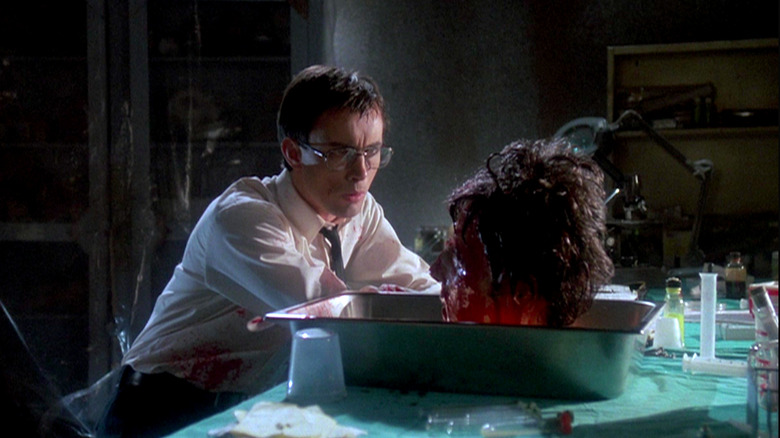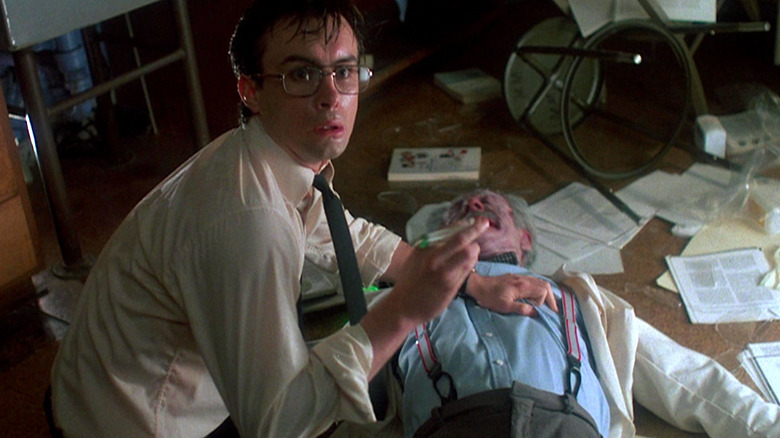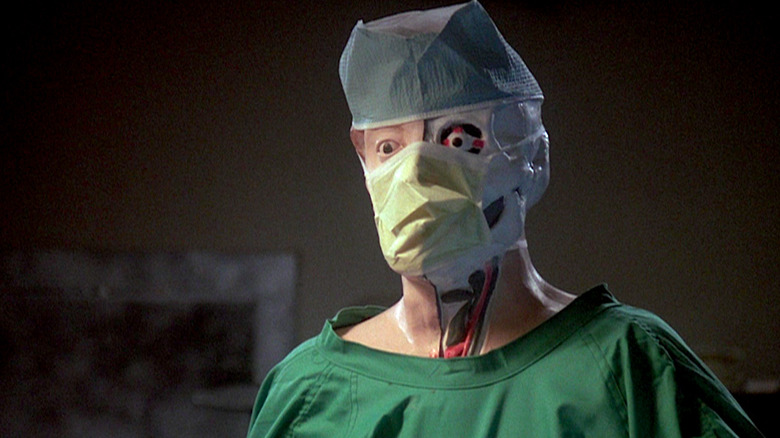The Main Difference Between Re-Animator's R-Rated And Unrated Versions
Stuart Gordon's deliciously deranged "Re-Animator" is a wild ride into the mind of Herbert West, a mad scientist determined to perfect the ability to bring the dead back to life. Based on H.P. Lovecraft's story, "Herbert West: Reanimator," Gordon's first feature film stars a plucky Jeffrey Combs as West, following him on his quest to perfect his reagent serum (no green ever looked so good) that has the power to reanimate the dead, albeit a bit ... incorrectly. The film is a classic within the horror community, beloved for the way it effortlessly blends comedy with over-the-top gore, and West's story even continues in two sequels, "Bride of Re-Animator" and "Beyond Re-Animator."
Those looking to watch "Re-Animator" for the first time will most likely find themselves faced with a choice of which version to view. Due to issues with the MPAA, the movie exists as both an R-rated version and an unrated version. Each offers a delightful viewing experience, but there are some key differences worth noting when trying to decide which version to watch.
To reject or embrace the gore
Perhaps the biggest difference between the R-rated and unrated versions of "Re-Animator" is its reliance on gore. This is a movie that is known for its bloody descent into madness, so to watch it with the gore turned down feels a little bit like listening to the Kids Bop version of "WAP." However, if this is what you are looking for, then the R-rated version is for you. Much of the blood and guts have been removed in favor of a more chaste depiction of West and his maniacal world. Ironically though, the R-rated version is slightly longer (93 minutes) than the unrated version which comes in at a short and sweet 86-minute runtime. The reason for this discrepancy in length comes down to the fact that cutting out all the blood and gore to meet the MPAA requirements meant that the film felt a little too short.
To remedy this, previously cut scenes were added back into the R-rated version to adjust the runtime. These scenes helped to flesh out some of the characters in the movie — there's a particularly interesting plot development with Dr. Hill who suddenly has the ability to use mind control — but the gore is dialed down quite a bit. I personally prefer the unrated version (which is the first version I saw and also happens to be Gordon's preferred cut), but there is something to be said for the R-rated version's reliance on more character development to make up for its lack of blood and guts. Thankfully though, if you find yourself wishing there was a version that combined the best of both worlds, you are in luck!
The integral version
Years ago, when you wanted to watch "Re-Animator," you were always forced to choose. More gore or more mind control? But thanks to the great people at Arrow Video, you no longer have to pick sides. In 2018, the company released an American version of "Re-Animator" that includes both a restored version of the unrated cut and the integral version which combines both the additional footage added into the R-rated version with all of the movie's original gore.
Basically, the Arrow release gives you the best of both worlds, if you so choose to watch the film this way. However, as mentioned earlier, Gordon prefers the unrated cut, so if you are a purist looking to watch the film the way the director intended, unrated is the way to go. Still, it's worth checking all the various versions out, especially if you are a die-hard fan of West and his reagent (which you definitely should be!). There are also some great extras on the Arrow release, including audio commentary with Gordon, producer Brian Yuzna, Jeffrey Combs, Barbara Crampton (swoon), and more, as well as a "feature-length documentary" about the making of the film that's well worth a watch.
Overall, it's a great addition to any horror fan's collection, and it's also a great way to explore the various versions of a deeply twisted horror classic.


